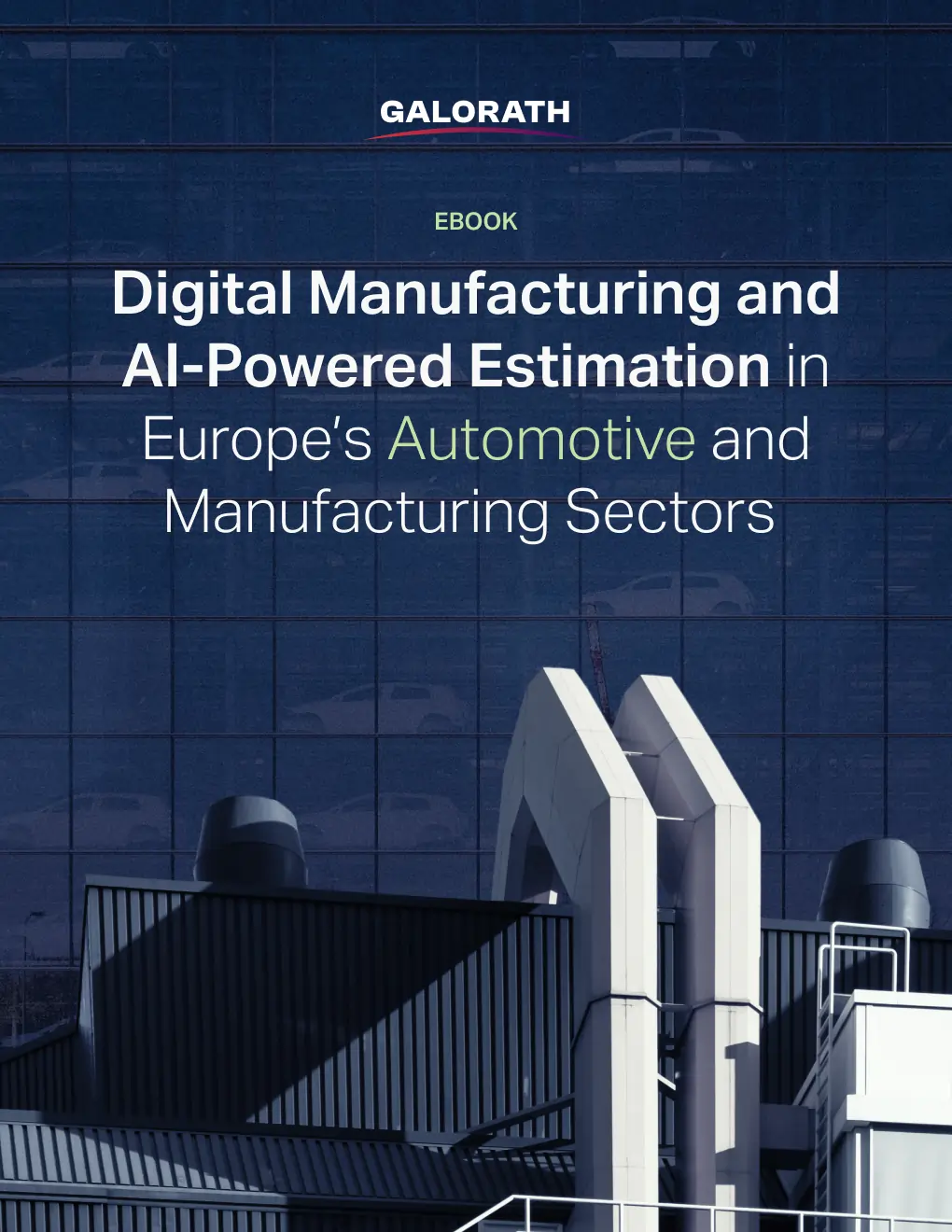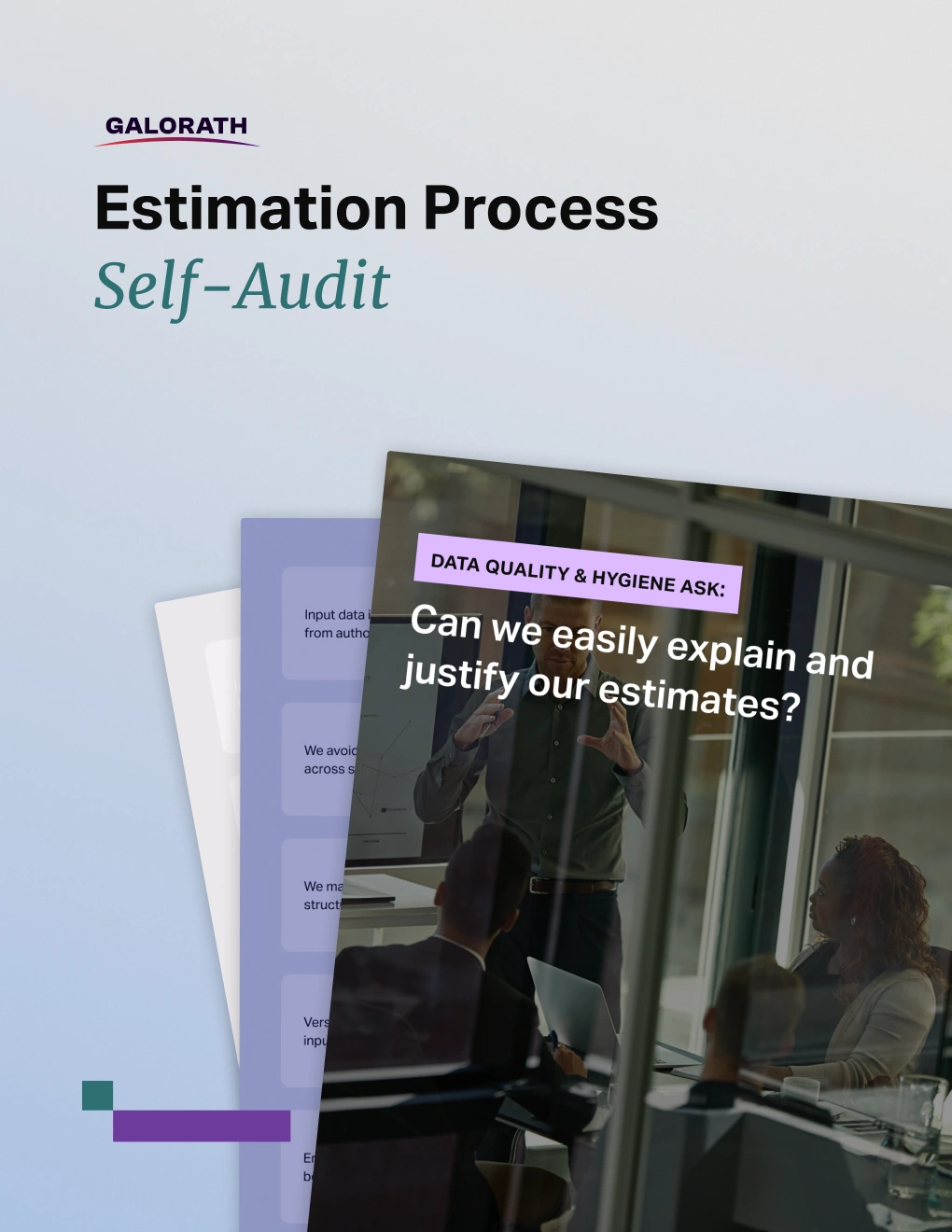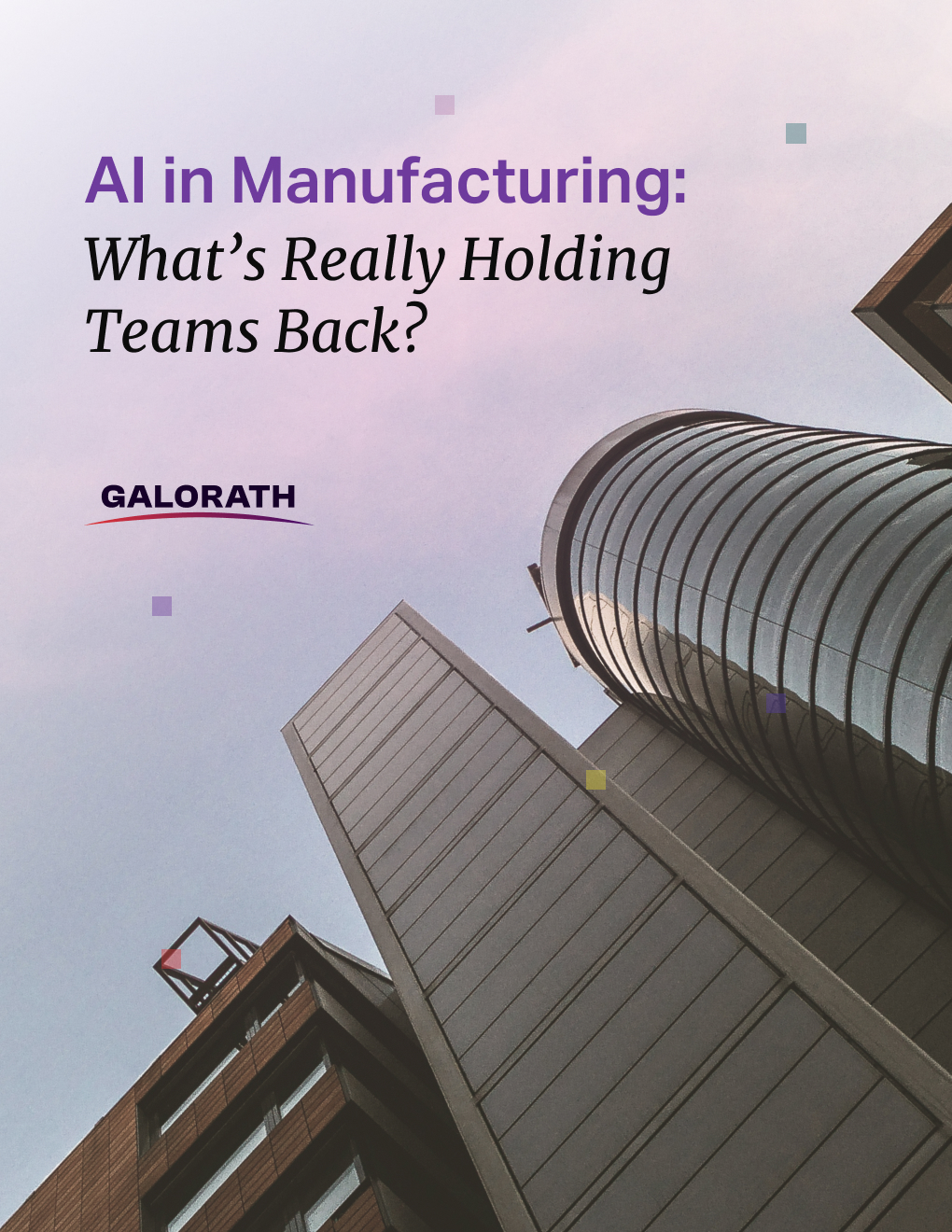Mastering Cost Risk with the CRED Model: A New Approach to Managing Uncertainty
Organizations seeking cost transparency can no longer rely exclusively on supplier quotes or historical pricing in today’s volatile, competitive markets. When a part quoted at $12 could feasibly be produced for $4, reactive pricing strategies fail to deliver accuracy or control.
Should cost analysis fills this gap by providing a strategic, data-driven framework for determining the optimal cost of products and services under efficient production conditions.
Should cost analysis employs bottom-up cost estimation by analyzing foundational cost drivers: raw materials, labor rates, overhead expenses, tooling, logistics, and supplier margins. Unlike top-down approaches relying on historical spend or vendor estimates, this methodology builds cost expectations from technical specifications and economic realities rather than subjective pricing.
Historically, the methodology was institutionalized within defense department cost engineering, with the U.S. Department of Defense pioneering its use during the Cold War. The objective was to counteract procurement inflation by establishing benchmark prices for weapons systems and support equipment. Since then, the practice has migrated into commercial sectors, becoming a core element of strategic cost management in industries such as aerospace, automotive, consumer electronics, and infrastructure.
Should cost analysis delivers transparency by decomposing costs into distinct drivers, empowering organizations to pinpoint inefficiencies, validate supplier pricing, and uncover cost-saving opportunities. This transparency supports strategic decisions in procurement, product development, and financial planning, promoting better trade-offs between price, quality, and speed.
“Should-cost analysis serves as a powerful negotiation tool, providing transparency and enabling discussions rooted in cost structure rather than arbitrary pricing.”
Today, predictive cost modeling capabilities, powered by AI-driven cost tools, enhance traditional cost estimation. Should cost analysis software solutions apply parametric cost modeling techniques to digital twins, enabling rapid simulations of product cost across geographies, production scales, and design alternatives. These tools ingest 3D CAD files, benchmark global pricing trends, and estimate costs in minutes rather than weeks.
“Companies are increasingly relying on predictive costing models to drive real-time decision-making and reduce design and sourcing inefficiencies.”
— The Top Five Trends Impacting Cost Engineering in 2024
This evolution signals a shift away from manual spreadsheets and retrospective estimates. Modern cost modeling platforms serve as integrated systems for real-time cost forecasting, enabling organizations to model how changes in design, material selection, or supplier region impact total cost throughout the product lifecycle.
Crucially, should cost analysis is a multidisciplinary effort. It depends on cross-functional cost teams, bringing together engineering cost expertise, procurement cost specialists, financial analysts, and market researchers. These teams align around cost targets, challenge assumptions, and use shared cost benchmarks to drive informed decision-making across the enterprise.
The following sections provide a structured exploration of should cost analysis, from theoretical foundations to applied use cases and software tools. Each component is analyzed in context to build a comprehensive understanding of how the methodology functions and why it has become indispensable for cost-conscious organizations.
Should cost analysis plays a critical role in strategic procurement and cost optimization. It begins with a formal definition of “should cost” and its historical significance in defense acquisition cost analysis. Key principles include the bottom-up estimating process and its benefits, along with its integration into cost engineering methodologies, procurement strategies, and product design.
The article also explores the roles and responsibilities of should-cost analysts and cost engineering teams, and highlights the use of advanced tools such as SEER for should cost analysis. Industry-specific applications, procurement transformation strategies, and common barriers to implementation are also addressed, along with practical solutions.
Finally, it compares should cost with related models such as will cost, actual cost, theoretical minimum cost, and cleansheet costing to provide a broader understanding of its position within cost analysis frameworks.
As supply chain volatility and pricing pressure intensify, should cost analysis evolves from a simple modeling technique into a strategic capability that reshapes how cost is understood, communicated, and managed across the enterprise.
You Can’t Negotiate Costs You Don’t Understand
SEER by Galorath reveals the true cost drivers behind labor, materials, processes, and complexity – giving you defensible Should Cost insights to validate supplier proposals, set cost targets, and eliminate hidden premiums before they become contractual.
What Is Should Cost Analysis?
Should cost analysis is a systematic method of estimating the optimal cost of products or services under efficient and competitive conditions by independently modeling materials, labor, tooling, logistics, and overhead, rather than relying on supplier quotes or historical prices.
“Should-cost analysis provides transparency into cost drivers and helps create a shared understanding of what drives price in a given product or process.”
— WSN-201-2025 Cost Engineering Insights
Definition of Should cost and its Strategic Role
The should cost definition refers to the theoretical, fact-based cost a product should incur assuming efficient manufacturing and fair profit margins. When applied as a methodology, it becomes a repeatable system for procurement cost estimation, design-to-cost planning, and supplier performance benchmarking.
Instead of replacing supplier pricing, should cost analysis establishes a validation benchmark. Significant gaps between this benchmark and a supplier’s quote can reveal inefficiencies or excessive margins, creating a foundation for data-driven negotiation.
Historical Origins of Should Cost: Defense Cost Control
The roots of should cost analysis trace back to the U.S. Department of Defense, which introduced the methodology during the Cold War to gain control over rising military procurement costs. The Defense Department institutionalized “should cost reviews” as part of its broader acquisition strategy, requiring contractors to justify costs with transparent, data-supported models.
“The concept of ‘should cost’ was formalized by the U.S. Department of Defense as part of an effort to improve acquisition outcomes by driving visibility into cost structures and improving negotiation outcomes.”
— A Systematic Review of the Digital Transformation of the Building Construction Industry
These principles laid the foundation for cost engineering methodology, influencing not only defense programs but also commercial industries seeking greater cost accountability.
Connection of Should Cost and Bottom-Up Estimating
At its core, should cost analysis applies a bottom-up cost structure, constructing estimates from detailed, individual inputs:
- Material costs per unit (based on BOM, scrap rates, sourcing)
- Labor hours and regional wage rates (per skill and shift)
- Machine and equipment usage (cycle time, depreciation)
- Overhead allocations (energy, maintenance, plant space)
- Tooling and setup time
- Compliance, testing, and quality control
- Profit margins (market-based, reasonable return)
Each value is modeled using engineering data, market intelligence, and historical benchmarks. Unlike top-down approaches, which apply aggregate cost ratios, this method delivers cost transparency at the component level, revealing both inefficiencies and optimization opportunities.
The structured nature of the process supports product development costing, allowing design teams to test material selections, manufacturing techniques, and geometry changes for cost impact before committing to production.
Precision vs. Practicality: The Limits of Should Cost Accuracy
While should cost analysis improves cost insight, it is not designed for perfect precision. Estimates typically fall within a ±10–20% accuracy range, depending on data granularity and supplier variability. Still, this margin of error is acceptable and even expected, given its role as a directional decision-support tool, not an exact forecast.
“Your should cost estimate is NOT 100% accurate—and that’s okay. The goal is to create transparency and stimulate meaningful supplier conversations, not to predict the final invoice.”
Actionable, directionally correct estimates are sufficient to guide:
- Sourcing evaluations
- Make-versus-buy analysis
- Design alternatives assessment
- Supplier negotiation strategies
This transparency helps stakeholders separate fact from fiction in supplier pricing and make better-informed trade-offs.
Strategic Impact of Should Cost to Modern Cost Control
The role of should cost analysis extends beyond estimating. It reinforces a broader philosophy of strategic cost management, one where organizations actively shape cost outcomes through informed decisions, not reactive measures. By applying this methodology early in the product lifecycle and embedding it into sourcing processes, companies gain sustainable cost advantages.
Who Performs Should Cost Analysis?
Should cost analysis is executed through a cross-functional framework that requires collaboration between engineering, procurement, and finance teams.This integrated structure ensures that technical precision, commercial insight, and financial accountability are embedded into every stage of the cost estimation process.
At the center of this effort is the should cost analyst, a specialist trained in manufacturing processes, cost modeling, and data interpretation. These professionals construct and validate detailed models based on product specifications, market benchmarks, and historical data. However, meaningful cost insights cannot be generated in isolation.
The Cross-Functional Should Cost Team Structure
Modern cost engineering teams integrate multiple disciplines to ensure that cost models reflect both technical and commercial realities.
Modern cost engineering teams integrate multiple disciplines to ensure that cost models reflect both technical and commercial realities. This collaborative effort typically includes:
- Design and manufacturing engineers – supply CAD files, process routings, tolerances, and material data required for bottom-up cost structures
- Procurement cost specialists – offer supplier knowledge, pricing trends, and sourcing strategies for procurement cost estimation
- Finance and controllers – validate total cost of ownership (TCO), ensure cost alignment with budgets, and assess margin expectations
- Product managers and operations leads – align cost objectives with product timelines, market targets, and supply chain requirements
This configuration facilitates cross-functional cost analysis that is collaborative, iterative, and transparent, enabling faster and more informed decision-making across product development and sourcing workflows.
Establishing Formal Cost Engineering Functions
To scale cost control capabilities, many enterprises formalize their efforts by establishing dedicated cost engineering teams. These units often operate within matrix organizations, embedded into both design and procurement units, allowing them to influence early product decisions while supporting supplier negotiations and RFQs.
“Cost engineering is no longer optional, it’s a core capability in competitive manufacturing environments.”
— Product Should Cost Software Turns Novices Into Cost Experts
By establishing this function formally, organizations embed cost engineering methodology into the entire product lifecycle, from concept design to final sourcing.
Expertise and Skills Required
Effective should cost analysts must bridge technical, analytical, and commercial domains. Their responsibilities span:
- Interpreting engineering drawings and 3D models
- Simulating manufacturing workflows and estimating resource usage
- Analyzing market intelligence, commodity prices, and labor rates
- Communicating findings clearly across engineering and procurement stakeholders
Proficiency in parametric cost modeling, supply chain cost analysis, and data-driven cost decisions is essential.
How Should Cost Analysis Works?
Should cost analysis demystifies supplier pricing by transforming engineering principles into a credible cost estimate. The logic rests on three pillars: a dynamic cost model that simulates production, market intelligence that grounds the model in reality, and a direct link to value engineering that drives proactive design choices.
The role of Cost Modeling in Should Cost Analysis
A cost model is a digital simulation of the manufacturing process. Instead of simply summing a static list of inputs, modern parametric cost models calculate costs by applying validated formulas and cost estimating relationships (CERs) to a product’s technical specifications.
This approach links attributes like material type, part complexity, and production volume directly to financial outcomes. It allows teams to generate reliable estimates and test “what-if” scenarios rapidly, even with the incomplete data typical of early-stage design.
The Role of Market Intelligence in Should Cost Analysis
A cost model is only credible if it reflects current economic conditions. Market intelligence provides this grounding by feeding the model with real-time data on commodity prices, regional labor and energy rates, and logistics costs. This integration transforms the model from a static snapshot into a dynamic tool that accurately accounts for supply chain volatility, inflation, and geopolitical risk.
The Link to Value Engineering and Design-to-Cost
Finally, should cost analysis serves as the financial backbone for value engineering and design-to-cost (DTC). It empowers engineering teams to quantify the impact of technical trade-offs before committing to a design, allowing them to answer critical questions:
- Material: Is the performance of titanium worth a 3x cost increase over stainless steel?
- Process: Can we save 15% by designing this part for die-casting instead of CNC machining?
- Complexity: How much cost does an unnecessarily tight tolerance add?
By providing this data, should cost analysis ensures products are engineered for profitability, not just performance.
How is Should Cost Analysis used to Drive Cost Savings?
Should cost analysis has evolved from a niche defense procurement tool into a cornerstone of strategic cost management. Today, it enables organizations to reduce spend, improve supplier performance, and identify cost-saving opportunities across product development, manufacturing, and sourcing functions. Its strength lies in delivering visibility and control, turning reactive cost management into proactive cost leadership.
From Effort-Heavy to Scalable Efficiency
Historically, building should cost models required deep engineering expertise, extensive data wrangling, and weeks of manual work. This complexity restricted usage to high-value defense programs or one-off cost disputes. That barrier has eroded. Modern parametric cost modeling and AI-driven platforms, such as SEER by Galorath, allow companies to scale cost insights across vast product portfolios in real time.
“Embracing parametric cost models brings the full impact of should-cost analysis to companies with large, diverse product catalogues, reducing the time and expertise required while maintaining best-quality analysis.”
With integrated cost modeling platforms, teams can now simulate, iterate, and compare thousands of product configurations across regions, materials, and suppliers, without relying solely on past prices or vendor quotes.
Enhancing Procurement and Supplier Negotiation
One of the most immediate impacts of should cost analysis is within procurement cost optimization. By establishing independent cost baselines, purchasing teams can validate supplier quotes, identify unjustified markups, and introduce pricing discipline across sourcing processes.
Instead of starting with the supplier’s number, teams begin with their own data-backed estimate, increasing negotiation leverage and improving trust through cost structure transparency.
How should cost analysis Supports Strategic Sourcing?
In traditional sourcing, decisions are often driven by historical relationships or lowest-bid wins. Should cost analysis shifts that dynamic. Using RFQ cost benchmarking, procurement leaders assess bids against internal models to isolate overpricing, misaligned assumptions, or differences in production efficiency.
By integrating supplier cost evaluation into the strategic sourcing process, organizations improve supplier selection based on technical cost alignment, not guesswork. This reduces total cost exposure and enhances supplier accountability over time.
Should Cost Reveals Total Cost of Ownership (TCO)
While price may win contracts, total cost of ownership analysis determines long-term value. Should cost models allow teams to look beyond initial unit costs to consider the full financial lifecycle, transportation, customs, serviceability, lead times, and end-of-life disposal.
By building lifecycle cost modeling into procurement strategy, companies avoid short-term savings that lead to long-term losses. This is particularly impactful for capital goods, complex assemblies, and global supply chains where hidden costs compound over time.
Benchmarking Cost and Supplier Performance
Should cost analysis creates a standard for supplier cost benchmarking. By comparing actual paid prices against internal estimates, procurement teams track supplier competitiveness, responsiveness to cost reduction targets, and pricing consistency across regions or programs.
These performance cost metrics evolve into key supplier scorecard inputs, driving continuous improvement and enabling corrective actions when costs diverge from expectations.
Optimizing Manufacturing Processes
Beyond procurement, should cost analysis optimizes manufacturing by identifying inefficiencies in production, labor usage, and material selection.
Engineers use models to simulate cost impacts of alternative materials, tolerances, production volumes, and machine setups. This empowers design teams to optimize bottom-up cost structures without compromising on function or delivery timelines.
Evaluating Bids and Proposals with Should Costing
In proposal reviews, bid evaluation costing provides an objective lens for assessing vendor submissions. Instead of relying on intuition or spreadsheet comparisons, teams use structured cost models to verify feasibility and detect underbidding risks.
This supports:
- Faster go/no-go decisions
- Improved proposal cost analysis
- Stronger alignment between sourcing and manufacturing constraints
Spend Analysis Applications
Should cost analysis enhances spend analysis by breaking down aggregate spending into component-level drivers. This enables teams to:
- Uncover categories with margin inflation
- Identify suppliers with inconsistent pricing
- Re-engineer components with disproportionate cost contributions
The result is improved procurement cost optimization through targeted negotiations, vendor consolidation, or design simplification.
Why It Works: Cost Visibility Becomes Actionable
“Should-cost analysis provides transparency into cost drivers and helps create a shared understanding of what drives price in a given product or process.”
— WSN-201-2025 Cost Engineering Insights
This shared understanding is the foundation for smarter sourcing, faster product iterations, and financially sustainable decisions across the value chain. As companies transition from siloed spreadsheets to connected cost intelligence platforms, the data-driven cost decisions enabled by should cost analysis become embedded in everyday operations.
By illuminating what drives cost, this methodology allows organizations to:
- Align sourcing and design decisions with real-world economics
- Preemptively correct inefficient specifications
- Strengthen supplier partnerships built on transparency
Expanding the Reach of Should Cost Analysis Beyond Procurement
While often associated with procurement negotiations, should cost analysis is not confined to vendor quote validation. Its real value emerges when deployed across the product lifecycle, from early-stage design to budgeting, change control, and even innovation strategy. As a data-driven methodology, it anchors decisions across the organization by linking technical feasibility with commercial viability
Driving Faster, Cost-Conscious Product Development
In complex design environments, failure to consider cost early leads to redesign, delays, or underperforming margins. Should cost analysis transforms product development costing into a proactive function. Rather than waiting for supplier feedback, engineering teams use parametric cost modeling (fed by digital twins, cost libraries, and CAD integration) to guide early-stage trade-offs.
This enables design-to-cost methodology workflows where cost is not a late-stage constraint, but a defining parameter from the outset.
Teams model different materials, geometries, and manufacturing routes before finalizing designs, reducing late-stage changes and accelerating time-to-market without compromising performance.
Strengthening Budget Forecasting and Financial Planning
Should cost estimates provide forward-looking visibility for financial planners who must model CAPEX/OPEX cost forecasting before quotes or contracts are finalized. These structured models allow teams to simulate scenarios across production geographies, batch volumes, raw material substitutes, or tooling investments.
As a result, budgeting cost forecasting becomes more grounded and responsive, helping organizations evaluate ROI, manage cash flow, and justify spending based on modeled assumptions rather than supplier promises.
Enhancing Supply Chain Cost Transparency
Global supply chains introduce complexity and opacity. Should cost analysis improves multi-tier supply chain cost visibility by modeling not just Tier 1 quotes, but deeper layers of production and logistics. Using regional labor rates, material indices, and energy inputs, teams uncover cost duplication, markup layers, and sourcing risks.
By integrating supply chain cost analysis into sourcing strategy, companies enhance their ability to:
- Model true landed costs
- Understand geopolitical or logistics risk exposure
- Improve supplier cost benchmarking across tiers
This clarity supports both operational resilience and supplier trust.
Improving the Precision of Contract Cost Management
Contract terms, especially those involving multi-year agreements or escalation clauses, usually carry hidden financial risks. Should cost analysis empowers contract management accuracy by validating proposed cost escalations against real market indices and modeled baselines.
By simulating pricing escalation analysis with current and historical cost data, teams can:
- Justify or challenge supplier increases
- Detect overcharges embedded in bundled services
- Align pricing clauses with commodity and wage trends
This results in leaner, more predictable contracts (especially crucial in capital-intensive or regulated industries).
Guiding Cost-Aware Engineering Change Management
Every engineering change carries a cost implication, but not every change justifies its expense. By integrating ECN cost impact assessments into the change management process, cost engineers help organizations evaluate whether technical modifications are financially viable.
Should cost models simulate revised processes, tooling, or materials in real time, enabling:
- Rapid impact forecasting
- Scenario testing of alternative changes
- Informed communication with suppliers or downstream customers
This ensures that engineering change costing is part of the decision and not an afterthought.
Prioritizing Innovation Based on Cost-Performance Value
R&D teams often operate under ambiguity: they must experiment freely while staying aligned with commercial targets. Should cost analysis supports innovation cost modeling by quantifying how new materials, processes, or architectures affect cost structures.
When evaluating ideas such as biodegradable polymers, additive manufacturing techniques, or modular components, teams can:
- Simulate cost-performance trade-offs
- Estimate investment payback periods
- Justify experimentation based on modeled savings
This enables R&D cost efficiency where investment prioritization aligns with measurable economic potential, not just novelty or intuition.
“Innovative teams use cost modeling early, treating it not as a limit—but a tool for smarter experimentation.”
— The Top Five Trends Impacting Cost Engineering in 2024
Across all of these domains – from engineering to finance – this bottom-up methodology empowers organizations by connecting cost structures directly to strategic outcomes, enabling faster and more defensible decisions at every stage of the product lifecycle.
Industry Applications of Should Cost Analysis
Although should cost analysis originated within defense acquisition, it has matured into a flexible framework used across virtually every major industry. From electric vehicles to infrastructure, it enables organizations to model, analyze, and manage costs with greater transparency and control. Each sector tailors the methodology to its own production complexities, regulatory constraints, and innovation cycles.
Automotive Cost Engineering Applications
In the automotive sector, automotive should cost engineering helps manufacturers navigate rising complexity from electrification, global sourcing, and evolving regulatory demands. Whether managing drivetrain platforms or infotainment modules, cost teams apply vehicle cost modeling to assess materials, assembly steps, and supplier margins in detail.
Automakers use parametric models to estimate costs across battery cells, castings, and cabin components, then simulate how design tweaks or supplier shifts impact cost. This design-to-cost discipline supports scalable, cost-efficient vehicle platforms across regional markets.
Government Contracting and Defense Analysis
Government agencies, particularly in defense, continue to rely on government cost compliance frameworks rooted in defense cost analysis practices. Here, should cost models are indispensable in verifying whether contractor pricing reflects economic reality, not inflated assumptions.
The methodology is tightly coupled with cost realism rules and audit readiness. By modeling expected inputs, labor hours, and tooling amortization, contracting officers ensure fair pricing and taxpayer value, whether evaluating satellite systems or military vehicles.
Mechanical Engineering Industry
For industrial equipment manufacturers, mechanical engineering should costing addresses the financial intricacies of large-scale assemblies and precision-built components. Products such as robotics systems or HVAC units require detailed equipment cost estimation based on tolerances, machining sequences, and batch production dynamics.
Cost engineers build models that simulate everything from weld bead lengths to automation feasibility, helping teams make early decisions that avoid cost overruns or post-production surprises.
Aerospace and High-Precision Manufacturing
Aerospace firms use aerospace should cost modeling to navigate stringent compliance environments and manage both direct and indirect costs. With should cost analysis, teams evaluate cost drivers across structural components, avionics, and propulsion systems.
Because aircraft cost analysis must reflect both recurring and non-recurring investments, should cost estimates include tooling amortization, testing protocols, and supplier readiness assessments, supporting more accurate bids, milestone budgeting, and risk mitigation across multi-year programs.
High Tech and Electronics Industry
In electronics and semiconductors, speed and scale are everything. Companies apply electronics should cost engineering to manage short design cycles, global BOMs, and ever-evolving part libraries. Whether modeling PCBs, displays, or chip assemblies, technology cost estimation must be both fast and precise.
Should cost platforms enable instant cost projections during NPI phases, where product decisions shape long-term profitability. Engineers and sourcing teams use real-time pricing feeds and CAD-linked tools to minimize cost creep while supporting agile design cycles.
Construction and Infrastructure Industry
Construction firms adopt construction cost analysis to bring structure and predictability to complex projects influenced by commodity markets, labor shifts, and site constraints. Whether for urban infrastructure or vertical buildings, infrastructure cost modeling enables breakdowns by systems, phases, and geographies.
Project owners and contractors use should cost tools to benchmark subcontractor pricing, validate escalation clauses, and adjust scopes based on evolving financial constraints, critical in public-private partnerships and regulated environments.
Consumer Goods and Packaging Industry
Fast-moving product lifecycles and brand-driven differentiation demand sharp cost control in consumer industries. Teams apply consumer goods costing to evaluate how formulation changes, manufacturing locations, or packaging tweaks impact unit economics.
With packaging cost optimization, procurement leaders assess materials, printing technologies, and supplier geographies, balancing sustainability targets and margin pressures. Should cost models inform both product development and seasonal SKU planning.
Energy and Utilities Industry
In capital-intensive sectors like renewables and grid infrastructure, energy cost modeling is foundational for budgeting, vendor selection, and project feasibility. Should cost models incorporate commodity price forecasts, labor access constraints, and regional logistics into total project cost projections.
For long-lifecycle assets, utilities cost analysis helps teams model multi-decade operating costs, evaluate turbine or transformer bids, and justify public funding requests. With growing investment in clean energy, should cost tools support cost discipline amid technological uncertainty.
Each of these industries uses should cost analysis not simply to reduce expense, but to build smarter, more accountable decision-making systems. From detailed product configurations to supplier negotiations and capital forecasting, the method ensures that cost becomes a strategic input – not an afterthought.
How to Do a Should Cost Analysis?
Should cost analysis is done through a four-step workflow: identify product specifications, research market rates for materials and labor, build a bottom-up cost model, and analyze results against supplier quotes. This structured method reveals true production costs and supports data-driven negotiation and sourcing decisions.
1. Identification of Product Specifications
A should cost analysis begins with a detailed understanding of the product’s design intent and functional requirements. Engineering drawings, CAD models, and bills of materials are reviewed to identify dimensions, tolerances, materials, and process characteristics. This phase defines the baseline for cost modeling by translating technical specifications into quantifiable cost drivers such as component complexity, surface finish, and assembly methods.
Key considerations include:
- Material composition and grade selection
- Manufacturing tolerances and quality standards
- Design complexity and geometry constraints
- Assembly, packaging, and logistics requirements
Establishing clear product specifications ensures that cost estimates accurately reflect realistic production conditions rather than generic averages.
2. Market Research for Material and Labor Rates
Once the technical baseline is established, cost engineers gather market intelligence for raw materials, energy, and labor. This step ensures that cost inputs mirror current economic conditions rather than static assumptions.
Typical data sources include:
- Commodity price indices (e.g., steel, aluminum, polymers)
- Regional labor rate databases and skill-based wage models
- Energy, transportation, and logistics costs
- Currency fluctuations and import/export tariffs
Integrating live market data provides a solid economic foundation for the model and enables sensitivity analysis to capture the impact of volatility or sourcing shifts.
3. Building a Should Cost Model
With engineering inputs and market data defined, the next phase constructs the bottom-up cost model. Each cost element, materials, labor, overhead, tooling, and profit, is quantified using validated cost estimating relationships (CERs).
A robust model typically includes:
- Bill of materials cost (unit quantity × market rate × scrap factor)
- Direct labor (cycle time × hourly rate × efficiency factor)
- Machine and tooling cost (depreciation × utilization rate)
- Overhead allocation (energy, maintenance, indirect labor)
- Profit and risk margin (based on industry benchmarks)
Modern parametric modeling tools allow teams to automate calculations, test alternative production scenarios, and generate transparent cost breakdowns for negotiation and decision-making.
4. Analyzing and Interpreting the Results
The final stage validates the should cost estimate against supplier quotes and internal benchmarks. The objective is not to reach a single “correct” number, but to identify deviations, inefficiencies, and opportunities for value improvement.
Typical analyses include:
- Variance comparison between modeled cost and supplier price
- Identification of primary cost drivers (materials, labor, overhead)
- Scenario modeling for production volume, region, or process changes
- Calculation of target cost ranges for supplier negotiation
Should cost analysis results inform strategic sourcing, supplier development, and design-to-cost initiatives by providing a credible, data-driven cost baseline for all stakeholders.
Complexity and Time Considerations
The duration and depth of should cost analysis vary according to product complexity, data availability, and organizational maturity.
| Complexity Level | Typical Duration | Characteristics |
| Simple Components | 2–4 weeks | Basic materials and processes; limited supplier tiers |
| Moderate Assemblies | 4–8 weeks | Multi-part BOMs; varied materials; regional cost inputs |
| Complex Systems | 8–16+ weeks | Cross-functional teams; multiple suppliers; iterative modeling |
Organizations often reduce cycle times after initial implementation by standardizing templates, automating data collection, and embedding cost modeling within PLM and ERP systems.
Tools and Software for Should Cost Analysis
As product complexity, global sourcing, and cost pressure increase, traditional spreadsheets and ad hoc methods can no longer support effective cost estimation. Should cost software solutions have emerged to meet this challenge, by providing structured, scalable, and data-rich environments for estimating the true cost of products and services.
These platforms provide comprehensive bottom-up modeling by analyzing all cost components: raw materials, labor rates, overhead, tooling, logistics, and profit margins. By digitizing this process, organizations move from manual estimation to streamlined, fact-based analysis, reducing turnaround time while improving accuracy.
Should Cost Analysis Software Overview
Modern cost modeling platforms are designed to integrate with enterprise tools such as ERP, PLM, and CAD systems. This integration enables automated ingestion of engineering drawings, BOMs, supplier catalogs, and historical pricing data and removes the friction traditionally associated with manual data entry.
What sets today’s platforms apart is their use of AI-driven cost tools. These tools not only automate repetitive calculations, but also detect pricing anomalies, simulate design changes, and generate cost estimates based on real-time market data. AI-based recommendations and learning loops make these platforms increasingly accurate over time, even for users without deep cost engineering experience. Leading should-cost analysis software solutions include SEER by Galorath, 4Cost, Costimator, and PRICE Systems.
“Digital costing platforms now combine CAD automation, market data feeds, and AI learning loops to deliver scalable, repeatable cost intelligence.”
— Product Should Cost Software Turns Novices Into Cost Experts
While each tool has its strengths, SEER is particularly notable for its precision, configurability, and suitability in highly engineered or regulated environments.
How SEER Helps with Should Cost Analysis?
SEER, a reputable should cost modeling software, is recognized for enabling accurate, early-stage cost estimation across a wide range of sectors, including aerospace, defense, electronics, and infrastructure. Developed by Galorath, SEER is built on a foundation of parametric cost estimation software that links technical specifications to financial outcomes using validated cost estimating relationships (CERs).
Unlike systems that require full BOMs or finalized CAD models, SEER can produce credible estimates from partial data. Inputs such as component weight, material type, geometry, and manufacturing complexity are enough to generate reliable results. This makes the tool highly effective during feasibility analysis, R&D planning, or competitive tender preparation.
SEER’s integrated cost analysis tools allow teams to:
- Model labor, material, tooling, and risk factors across multiple scenarios
- Perform sensitivity analysis to understand cost drivers and risk exposure
- Maintain traceable audit trails for compliance and stakeholder validation
- Align estimates across engineering, procurement, and finance
Its value extends across multiple project types:
- Government contracts that require transparent pricing and audit compliance
- Low-volume, high-complexity manufacturing where traditional averages fall short
- CAPEX/OPEX project planning for infrastructure, energy, or R&D programs
- Design change validation, where rapid simulations of cost impact are critical
“SEER’s parametric engines reduce the time to build credible cost estimates from weeks to hours—without compromising accuracy.”
— Cost Estimating Handbook, Rev. 2 (2023)
Organizations that adopt SEER benefit from faster quote cycles, improved supplier negotiations, and the ability to make early, informed decisions, without relying on guesswork or inflated vendor pricing.
The Challenges of Implementing Should Cost Analysis
Despite its benefits, implementing should cost analysis is not without obstacles. Organizations often encounter a mix of data, talent, process, and system challenges that must be addressed to ensure long-term success. These should cost implementation challenges affect both strategic vision and day-to-day operations.
Data Quality and Availability Issues
Robust cost modeling depends on access to accurate, timely, and granular data. Yet, many teams operate with fragmented systems, inconsistent master data, or outdated inputs. These cost analysis barriers undermine model credibility and limit the value of the insights produced.
Common gaps include:
- Missing or outdated specs on materials, tolerances, or regional labor rates
- Limited visibility into Tier 2 or Tier 3 supplier pricing
- Static data disconnected from real-time commodity trends or inflation
Without structured data governance, even the best tools will produce unreliable results.
“You can’t expect credibility from a should cost model if you’re feeding it stale or incomplete inputs.”
— Cost Estimating Handbook, Rev. 2 (2023)
Skills and Expertise Requirements
The effectiveness of a should cost initiative often hinges on specialized skill sets. Many companies struggle to recruit or train professionals who can bridge engineering, procurement, and finance.
This results in:
- Engineers unfamiliar with market-driven cost drivers
- Analysts lacking technical manufacturing context
- Procurement teams without modeling experience
A successful program often requires forming cross-functional cost engineering teams or dedicated analyst roles that combine these disciplines under one methodology.
Overcoming Organizational Resistance and Driving Adoption
Introducing should cost practices can be met with resistance. Perceived as disruptive or even threatening to supplier relationships, some teams hesitate to adopt a model-driven approach. A lack of organizational readiness often derails these initiatives before they mature.
Challenges include:
- Misalignment between engineering and sourcing teams
- Concern from suppliers over cost transparency expectations
- Inertia due to reliance on legacy quoting or price-based sourcing
Effective change management includes executive sponsorship, pilot programs that deliver early wins, and a clear narrative that frames should cost as a driver of collaboration—not conflict.
Technology Integration Challenges
Even the best AI-driven cost tools can underdeliver without proper integration into enterprise systems. Lack of connectivity to ERP, PLM, or CAD platforms leads to duplicate data entry, disconnected workflows, and reliance on external spreadsheets.
Issues that arise:
- Limited or inconsistent master data synchronization
- Inadequate API support or customization options
- Steep learning curves without proper onboarding
Choosing the right platform—and ensuring it fits into existing toolchains—is essential for scalability.
By acknowledging these implementation barriers early, organizations can build the infrastructure and alignment required for success. When deployed with the right tools, teams, and governance, should cost analysis evolves from an isolated function into a strategic capability embedded across the product lifecycle.
Cost Estimation Models and Related Concepts
While should cost analysis has become a cornerstone of strategic cost management, its full value emerges when viewed alongside other key cost estimation frameworks. Understanding how it compares to actual cost, will cost, theoretical minimum cost, and cleansheet costing helps organizations select the right method for each decision-making context. Each model serves a distinct purpose, from strategic negotiation to long-term R&D planning.
Should Cost vs. Actual Cost
Actual cost is the final amount paid for a product or service after completion of procurement, production, delivery, and associated transactions. It is retrospective, grounded in completed events and confirmed expenditures.
In contrast, should cost benchmarking offers a forward-looking estimate—calculated from raw materials, labor, overhead, logistics, and profit margins under efficient production conditions. It represents what something ought to cost, rather than what it did.
This comparison enables cost performance measurement, offering a transparent method for evaluating whether suppliers are pricing fairly or if inefficiencies exist in the sourcing process.
For example:
- If the actual cost comparison reveals a supplier’s quote is 20% above the should cost estimate, procurement can probe for justifications—such as excessive markup or underutilized capacity.
- If actual spend is significantly below the modeled cost, this may trigger a review of potential quality issues, sustainability risks, or non-compliance.
“Should cost is not the final price—it’s the yardstick you measure it against.”
Rather than replacing actual cost data, should cost models complement it, providing a performance benchmark that enhances pricing transparency and supports continuous improvement across categories and suppliers.
Should Cost vs. Will Cost
While should cost defines what a product should cost under ideal conditions, will cost analysis reflects the expected price in a real market scenario. The market cost reality includes factors such as supplier behavior, competitive dynamics, geopolitical risks, and the buyer’s negotiation leverage.
In practice, will cost is what the organization is most likely to pay—shaped by constraints, urgency, and external conditions. It’s a practical forecast used in budgeting and vendor negotiations.
Should cost analysis plays a critical role in identifying and narrowing the negotiation cost gap, the difference between theoretical fairness and market pricing. This insight empowers teams to:
- Validate supplier quotes against modeled expectations
- Justify cost targets internally and externally
- Engage suppliers in value-focused, evidence-based discussions
“Should cost is what’s fair; will cost is what you’ll probably pay—and the gap is where negotiation happens.”
By comparing should cost to will cost, sourcing leaders gain a clearer view of pricing risk, identify high-impact negotiation opportunities, and sharpen their forecasting models.
Should Cost vs. Theoretical Minimum Cost
While should cost analysis models an efficient real-world scenario, theoretical minimum cost represents a purely aspirational benchmark: the absolute lowest cost to produce an item under perfect conditions. This model assumes zero waste, flawless operational efficiency, and the use of the most advanced technology available globally, regardless of its current accessibility or cost.
Unlike a should cost estimate, the theoretical minimum is not used for supplier negotiations. Its value lies in guiding long-term innovation and R&D strategy. By comparing the “should cost” to the “theoretical minimum,” leaders can identify the gap between current efficiency and future possibility. This gap highlights opportunities for breakthrough process innovations or transformative technology investments, rather than just incremental improvements.
Think of should cost as your map for the current terrain, and theoretical minimum cost as the North Star guiding your long-term journey toward ultimate efficiency.
Should Cost Analysis vs. Cleansheet Costing
While should cost analysis provides a high-level, strategic benchmark of expected costs, cleansheet costing methodology dives deeper, offering a granular cost analysis of every component, process, and overhead contributor from the ground up.
Cleansheet costing (also known as “clean sheet” or “zero-based” costing) is typically used in engineering-intensive industries where cost accuracy and traceability are paramount. It breaks down a product’s cost into raw materials, labor, tooling, equipment depreciation, packaging, logistics, and supplier margin – basing each on direct data or engineering formulas. This makes it an engineering cost approach, used for cost validation, supplier discussions, and VA/VE initiatives.
| Comparison | Should Cost Analysis | Cleansheet Costing |
| Purpose | Benchmarking & negotiation | Detailed cost breakdown |
| Granularity | Medium | Very high |
| Approach | Top-down + bottom-up | Fully bottom-up |
| Use Case | Strategic sourcing | Engineering validation |
| Tools Used | SEER, aPriori | Excel, Costimator, 4cost |
“Cleansheet costing substantiates should cost models by building up every dollar from the ground level.”
Should cost analysis transforms reactive cost management into proactive cost leadership. By implementing this methodology, organizations gain a sustainable competitive advantage built on transparent cost structures, informed supplier negotiations, and data-driven product development decisions.
Should cost analysis remains a strategic enabler of cost transparency, empowering organizations to identify 10–20% savings through structured, data-driven cost modeling and supplier benchmarking. As digital transformation advances, AI-powered cost intelligence will further integrate engineering, procurement, and finance, transforming cost management into a continuous, predictive enterprise capability.








